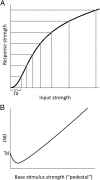Improving visual sensitivity with subthreshold transcranial magnetic stimulation
- PMID: 21368040
- PMCID: PMC6623934
- DOI: 10.1523/JNEUROSCI.6256-10.2011
Improving visual sensitivity with subthreshold transcranial magnetic stimulation
Abstract
We probed for improvement of visual sensitivity in human participants using transcranial magnetic stimulation (TMS). Stimulation of visual cortex can induce an illusory visual percept known as a phosphene. It is known that TMS, delivered at intensities above the threshold to induce phosphenes, impairs the detection of visual stimuli. We investigated how the detection of a simple visual stimulus is affected by TMS applied to visual cortex at or below the phosphene threshold. Participants performed the detection task while the contrast of the visual stimulus was varied from trial to trial according to an adaptive staircase procedure. Detection of the stimulus was enhanced when a single pulse of TMS was delivered to the contralateral visual cortex 100 or 120 ms after stimulus onset at intensities just below the phosphene threshold. No improvement in visual sensitivity was observed when TMS was applied to the visual cortex in the opposite hemisphere (ipsilateral to the visual stimulus). We conclude that TMS-induced neuronal activity can sum with stimulus-evoked activity to augment visual perception.
Figures



References
-
- Allen EA, Pasley BN, Duong T, Freeman RD. Transcranial magnetic stimulation elicits coupled neural and hemodynamic consequences. Science. 2007;317:1918–1921. - PubMed
-
- Amassian VE, Cracco RQ, Maccabee PJ, Cracco JB, Rudell A, Eberle L. Suppression of visual perception by magnetic coil stimulation of human occipital cortex. Electroencephalogr Clin Neurophysiol. 1989;74:458–462. - PubMed
-
- Arabzadeh E, Clifford CW, Harris JA. Vision merges with touch in a purely tactile discrimination. Psychol Sci. 2008;19:635–641. - PubMed
-
- Barker AT, Jalinous R, Freeston IL. Non-invasive magnetic stimulation of human motor cortex. Lancet. 1985a;1:1106–1107. - PubMed
-
- Barker AT, Freeston IL, Jalinous R, Merton PA, Morton HB. Magnetic stimulation of the human brain. J Physiol (Lond) 1985b;369(Suppl):3P.
Publication types
MeSH terms
LinkOut - more resources
Full Text Sources
